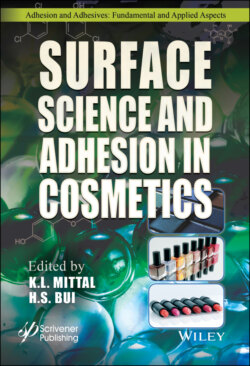Читать книгу Surface Science and Adhesion in Cosmetics - Группа авторов - Страница 79
3.7.1 Formulation of a UV Nail Gel Using a UV Cure Polyurethane Dispersion (UV-PUD)
ОглавлениеFormulation of UV nail gel with UV cure polyurethane dispersions (UV-PUDs) is a newer technology that has evolved in the UV nail gel industry which relies on water-based technology. This technology has its roots in the development that instead of using (meth)acrylate monomers that were described in Figure 3.13 it uses water to reduce the ‘use viscosity’ of the system. This technology can be described as a UV-PUD and is unique in that its molecular weight can be greater than 200,000 daltons and yet has extremely low viscosity when diluted into water.
UV-PUDs are manufactured similarly to the 100% solids UV cure oligomers except for additional dispersion step and chain extension. In Figure 3.16 we show an aliphatic diisocyanate reacting with an aliphatic polyester polyol in combination with a diol dispersant, forming a diisocyanate prepolymer. This isocyanate prepolymer is then dispersed with a volatile tertiary amine in water followed by chain-extending the isocyanate prepolymer. This then results in the formation of an aqueous polyurethane dispersion. The final step is the removal of the acetone by way of a special distillation technique that separates the acetone from the water. These UV-PUDs are typically 40% solids in water [12]. Several patents and patent applications have been granted for the use of UV-PUD technology in UV nail gel industry. Two of these patents take the UV-PUD and combine it with a non-UV cure PUDs and limit the amount of TPO/BAPO PI described in Figure 3.15 [13, 14]. The benefits of these two patents are the low-level use of the TPO/BAPO PI that was shown in Figure 3.15. These two patents claim less than or equal to 2 % of the TPO/BAPO PI which just happens to be well under the 5% regulatory limit for this type of PIs in cosmetic products. The colorant option is also reviewed in these patents and was shown to meet SCCS testing requirements for the UV nail gel industry [15]. Another more recent patent application claims the compositional aspect of the UV-PUD in combination with the final use formulation. These formulations contain no solvents or co-solvents and can result in low viscosities of 500 to 3000 cPa.s at a application solids of 20 to 30% in water. These systems also respond to UV-A LED light sources by utilizing the TPO/BAPO PIs that were described earlier [16].
Figure 3.16 Typical UV Curable Polyurethane Dispersion Synthesis [12].
